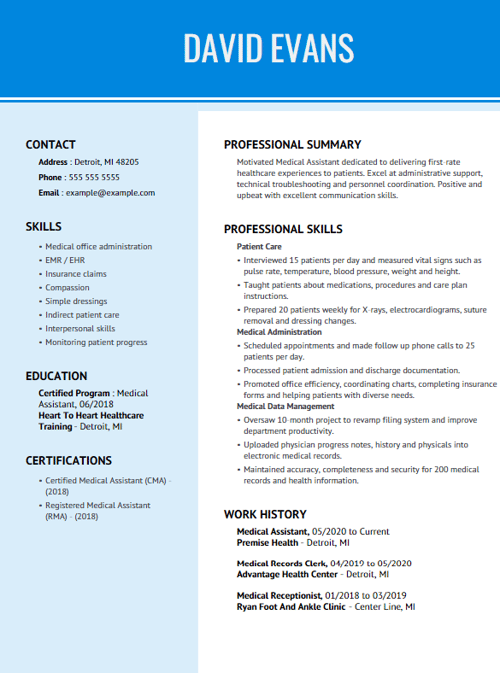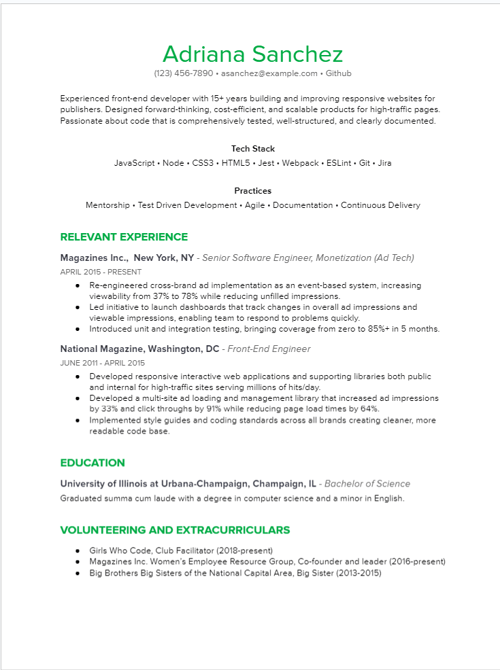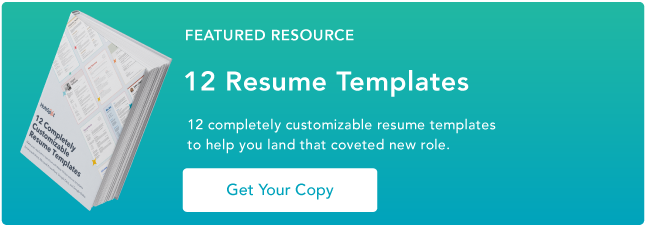The content of your resume is as important as the format used in presenting the resume. Put another way, crisp resume content plus the best resume format is the perfect match for getting hired for a role.
In this post, you’ll learn about the best resume formats, their pros and cons, and when to use each one. Let’s dive in.
Table of Contents
- What are the different resume formats?
- Chronological Resumes — How do they work?
- Functional Resumes — How do they work?
- Combination Resumes — How do they work?
What are the different resume formats?

There are three standard types of resume formats:
- Chronological resume. This resume shows your relevant work experiences and achievements, beginning with the most recent one. It’s the most used of the three resume formats and suits people with lots of work experience.
- Functional resume. This resume emphasizes your skills over your work experience. It suits anyone who’s switching careers and individuals who have employment gaps.
- Combination resume. As the name suggests, this resume format blends the first two. It highlights both your skills and experiences but presents them chronologically. The combination resume is most suitable for seasoned professionals with lots of work experience and accomplishments.
Let’s consider how each of these resume formats works.
Chronological Resumes — How do they work?
These resumes focus on your work experience by listing your employment history in reverse chronological order, i.e., from your current or most recent job to the oldest.
Each work experience includes your job title, company name, employment start and end date, achievements, and job duties.
Many recruiters consider chronological resumes — or reverse-chronological resumes — as the standard resume format. One reason for this is their familiar structure, which makes it easy for recruiters to skim and determine if you’re the right fit for the job.
Moreover, chronological resumes help recruiters spot gaps or notice consistency in your work history.
Consider using this resume format if you’re a veteran in a particular field. By highlighting your career growth and progression, you get an edge when transitioning between jobs in the same field.
All factors considered, chronological resumes are the best all-around choice for job seekers.
Below is the typical structure of a chronological resume:
- Name
- Contact information
- Resume summary
- Work experience
- Education
- Skills
Limitations of Chronological Resumes
Despite their popularity, chronological resumes have certain disadvantages. Here are three major shortcomings of chronological resumes you should consider.
1. Chronological resumes make career gaps obvious.
Career gaps on your resume aren’t a deal breaker. However, they raise questions in a recruiter’s mind and can hamper your chances of getting an interview. That’s why, if you have gaps in years, having a resume that creatively conceals them is helpful.
Unfortunately, the sequential order of the chronological resume makes it impossible to hide any career gaps.
2. Chronological resumes could bury early career achievements.
Your key achievements are an excellent way to show employers the value you can provide. You need to front-load this information on your resume.
But here’s the thing: Key achievements from your early career roles will always stay at the bottom of your resume. As such, recruiters who find your recent achievements unappealing may not read further.
3. Chronological resumes are not ideal for recent graduates or career switchers.
Recent graduates and career switchers typically lack related work experience.
As the work experience section is the dominant section of the chronological resume, the lack of experience becomes obvious, making this format less suitable.
Best Practices for Writing a Chronological Resume
1. Craft a compelling summary.
Treat your resume summary like a news headline. Whether you’re reading news online or picking up a newspaper, you don’t read every story. You scan for interesting headlines, read the content, and ditch the rest. It’s the same with resumes.
Often, you’ll have about 7.4 seconds to grab the recruiter’s attention. So use it well by writing a summary that markets you as the best candidate for the role.
2. Highlight achievements, not responsibilities.
What matters to recruiters isn’t what you did but the impact of your work. So refrain from listing vague job duties that a recruiter may know.
Instead, show the specific outcome of your work by communicating in percentages, numbers, revenue, etc. Or, if your job experience doesn’t lend itself to numbers, use strong verbs to describe your achievements briefly.
See how Jeff Su tweaks his resume to show his achievements rather than using meaningless buzzwords:
3. List relevant job experiences only.
Adding unrelated job experiences to your resume weakens its impact. If you have any irrelevant work experience, it’s best to leave it out.
Yes, this will appear as a career gap to recruiters. But if your experience is good enough for a role, it won’t matter.
4. Don’t place your Education above your Work Experience section.
If you graduated with spectacular grades from a big-name university like Princeton, you might want to show it off at the top of your resume. But that’s a bad idea.
Recruiters value work experience over high academic achievement, and for good reason — work experience of any form is a stronger predictor of your on-the-job performance.
Examples of Chronological Resumes
Let’s take a look at some stellar examples of chronological resumes so you can visualize how the format works when creating your own.
1. Management Consultant

What we like:
- Sells his value using meaningful metrics. Quantifying the impact of one’s contribution using percentages, revenue, and other meaningful metrics should be a popular resume-writing best practice. Yet, only 26% of resumes included at least five instances of measurable results. Plus, 36% of resumes use no metrics, according to Austin Belcak’s analysis of 125,000+ resumes.
- Excludes a resume summary. Including a summary will turn this one-page resume into two pages. Those are less desirable alternatives. We suspect that’s why Jeff excluded the resume summary, and that’s smart in this case.
Pro tip: Unless you’re an academic or C-level executive, try to fit your resume on one page by using font 11-12 for body text and 14-16 for headings. Adjust your margins, too.
2. Massage Therapist

What we like:
- Tells a compelling career story. This resume shows a clear career path from massage therapist intern to senior massage therapist within five years.
- Easy to read. Many resumes are cluttered and hard to scan. This one is readable.
Pro tip: The content of your resume is far more important than its design. Except if you’re applying for a graphic design role, a creative resume design has little impact on your chances of getting an interview.
Functional Resumes — How do they work?
Functional or skills-based resumes emphasize your skills and accomplishments. Unlike chronological resumes, where you group your accomplishments in the work history section, functional resumes let you group achievements in the skills category.
This format is ideal where you’d rather show your skills than your career progression.
For instance, if you’re switching careers, your work history will probably be unrelated to the role you’re applying for. To impress a recruiter, you must show your transferable skills that apply to the role. A functional resume helps you do that.
Functional resumes are also suitable for someone with career gaps. It dims the lights on your work experience, so gap years aren’t obvious. Recent graduates with many skills but little professional experience may use the functional resume, too.
Limitations of Functional Resumes
Although the functional resume format solves common concerns job seekers have, it’s the least recommended and least used resume format. Here are three reasons for its unpopularity:
1. Functional resumes are stigmatized by recruiters.
Recruiters dislike this resume format. Functional resumes have a reputation for being deceptive. Some recruiters believe they’re used to minimize appearances of job hopping.
When recruiters see a functional resume, they become suspicious. They imagine you have something to hide. This makes them less likely to read your resume thoroughly.
2. Functional resumes don’t tell the full career story.
Beyond stigma, recruiters are sometimes interested in the information a functional resume hides.
They want to know your work history, gauge your career progression, and see how recently you gained some of your skills — the sort of detail clearly communicated in the chronological format. The absence of this information makes your resume less convincing.
3. Functional resumes are less ATS-friendly.
To save time and money, companies use computer software known as applicant tracking systems (ATS) to screen resumes.
Only resumes that beat the ATS ever get read by human recruiters. Studies show that 75% of resumes never make it through. Using a functional resume increases your chances of entering that pile.
Best Practices for Writing a Functional Resume
1. Include relevant skills only.
Your functional resume is already missing your work history, which is key information recruiters want. You don’t have a leg to stand on if you don’t highlight your relevant skills.
To impress recruiters, identify and list only your most-relevant transferable skills. Also, ensure you list the skills in order of relevance, starting from the most relevant or most in-demand to the least relevant.
2. Describe your skills using keywords from the job ad.
Recruiters program ATS to select resumes that use keywords, such as job titles and skills related to the role.
If you’re changing careers, your resume probably doesn’t include relevant job titles. So if your listed skills don’t include the skills the ATS scans for, you likely won’t get an interview.
3. Exclude skill bars.
Skill bars look creative, but they don’t help you stand out. In fact, they can turn off some recruiters. Why?
“They’re innately subjective and therefore unreliable. They are meaningless, visually distracting, detract from the professional appearance of your resume, and turn it into a cheesy-looking flier,” says Alice Baker.
What’s worse? They make your resume less ATS-friendly. So it’s safer to stay away from them.
4. Include your work history.
Even if you have career gaps or unrelated job experience, including skeletal details about your work history is a good idea. It could help alleviate a recruiter’s suspicion that you’re a chronic job hopper.
List the job title, company name, company location, and date for each position you held. Use years instead of months to show your work experience to make the gaps less obvious.
Examples of Functional Resumes
Now let’s turn to some examples to see this resume format in action.
1. Health Copywriter

What we like:
- Shows relevant, niche experience. The resume shows industry knowledge by revealing that the applicant minored in healthcare and has working experience as a medical receptionist and health copywriter.
- Quantifies impact using figures. The applicant uses percentages and other meaningful metrics to describe the impact of their work.
Pro tip: Use this double-columned resume style to put more information on the page while keeping it organized and easy to read.
2. Medical Assistant

What we like:
- Shows career trajectory. This resume shows the candidate’s career trajectory from being a medical receptionist to a medical assistant. That’s something you don’t always see in functional resumes.
- Minimal and easy-to-scan layout. Given the abundance of white space, the candidate could have included visual elements such as skill bars or pictures, but the applicant did not. This makes it easy to read and keeps the focus on what matters.
Pro tip: Though some resume templates let you include your picture on your resume, you shouldn’t do so. To avoid being accused of discriminatory practices, some companies have a policy of tossing out resumes that have the applicant’s pictures.
Combination Resumes — How do they work?
Combination resumes (a.k.a. hybrid resumes) focus equally on skills and work history. It captures a recruiter’s attention by listing your most relevant skills and achievements at the top of the resume.
It then supports those skills with a chronological timeline of your relevant work experience.
The combination resume format offers the best of both worlds to job seekers who have lots of skills and a consistent employment track.
This makes it suitable for senior professionals with diverse skills and accomplishments. It’s also useful for career switchers or experienced applicants with employment gaps.
Limitations of Combination Resumes
Combination resumes, like functional resumes, are rare. So unless you have a good reason, it’s best not to use them. In addition, they have these limitations:
1. Combination resumes are challenging to prepare.
One page per 10 years of experience is a good rule of thumb for resume length. But that’s harder to achieve when your goal is to highlight your skills and relevant work history. This is much easier to achieve using the chronological resume format.
2. Combination resumes may appear repetitive.
Some of your skills may apply to different positions. Including this detail could make your resume appear repetitive. One way around this is to drill down on the outcomes of the tasks performed rather than the tasks themselves.
Best Practices for Writing a Combination Resume
1. Tailor every experience to the job position.
Applying to every job out there doesn’t work in today’s market. What works is creating a tailored resume for each application.
Yes, creating a unique resume for every job opening is some work. However, doing this will make you send fewer applications with better success odds.
Consider preparing a master resume or what Austin Belcak calls a results tracker. This is a long, regularly updated journal containing every job, project, and accomplishment you’ve had.
That way, you can quickly collect relevant experience and tailor your resume to job openings.
2. Expand on the results accomplished with each skill.
When filling out the skills section, you may list your key skills without elaborating. However, including a bullet list of your past responsibilities and accomplishments for each skill is more impactful.
3. Order your skills strategically.
The order of presenting your skills matters. Ideally, you should prioritize the skills listed in the job description and those most important in your field, listing your accomplishments under each skill category.
And while you’re at it, ensure you’re first showing skills that help you front-load your most significant achievements.
Examples of Combination Resumes
Review the examples below to see how two candidates created impactful combination resumes.
1. Marketing Manager

What we like:
- Relays past responsibilities and achievements for each skill using bullets. Using bullets makes a resume easy to scan and read when done correctly. However, some of these bullets have meaningless buzzwords that do not illustrate the candidate’s value, quantify results, or grab attention.
Pro tip: Avoid repeating the same skills between the skills and experience sections. While the first should obviously highlight your skills, use the second to share your achievements.
2. Senior Software Engineer

What we like:
- Crisp, compelling, and digestible resume summary. The resume summary is easy to read, which is great since recruiters scan resumes quickly. It also sets a nice tone for the rest of the resume.
- Tells a compelling career story. This applicant’s career spans 15+ years in the publishing industry. Yet, the applicant has only worked two jobs. That shows commitment and indicates the candidate does great work.
Pro tip: Only include extracurriculars and volunteering if those activities are relevant to the position you’re applying for and if they highlight achievements that you didn’t also have in your professional career.
Writing a Winning Resume
Your desired role is only a few applications away. And you now know how to determine the resume format that best suits your situation.
So choose the best resume format that works for you, and create a winning resume that lands your dream role. You can also get started with our resource library of resume templates.



